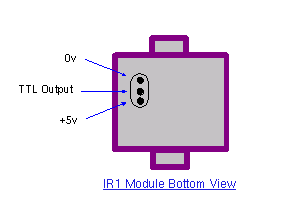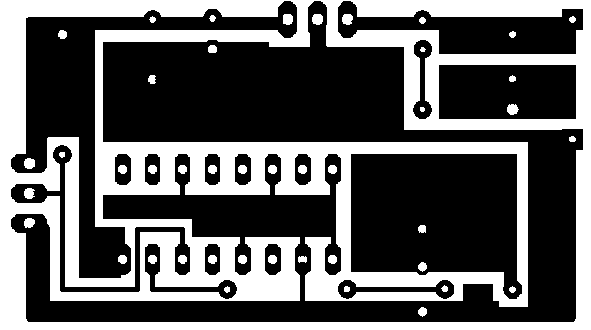|
This is an improved IR remote control
extender circuit. It has high noise immunity, is
resistant to ambient and reflected light and has an
increased range from remote control to the extender
circuit of about 7 meters. It should work with any
domestic apparatus that use 36-38kHz for the IR carrier
frequency. Please note that this is NOT compatible with
some satellite receivers that use 115KHz as a carrier
frequency.
Click here to View Circuit
The main difference between this version
and the previous circuit, is that this design uses a
commercially available Infra Red module. This module,
part number IR1 is available from Harrison Electronics
in the UK. The IR module contains a built in photo
diode, amplifier circuit and buffer and decoder. It is
centerd on the common 38kHz carrier frequency that most
IR controls use. The module removes most of the carrier
allowing decoded pulses to pass to the appliance.
Domestic TV's and VCR's use extra filtering is used to
completely remove the carrier. The IR1 is packaged in a
small aluminium case, the connections viewed from
underneath are shown below:

Infra Red Module, IR1 Pinout
The IR1 module (IC3) operates on 5 Volt
dc. This is provided by the 7805 voltage regulator, IC1.
Under quiescent (no IR signal) conditions the voltage on
the output pin is high, around 5 volts dc. This needs to
be inverted and buffered to drive the IR photo emitter
LED, LED2. The buffering is provided by one gate (pins 2
& 3) of a hex invertor the CMOS 4049, IC2. The IR1
module can directly drive TTL logic,but a pull-up
resistor, R4 is required to interface to CMOS IC's. This
resistor ensures that the signal from a remote control
will alternate between 0 and 5 volts. As TTL logic
levels are slightly different from CMOS, the 3.3k
resistor R4 is wired to the +5 volt supply line ensuring
that the logic high signal will be 5 volts and not the
TTL levels 3.3 volts. The resistor does not affect
performance of the IR module, but DOES ensure that the
module will correctly drive the CMOS buffer without
instability.
The output from the 4049 pin 2 directly
drives transistor Q1, the 10k resistor R1 limiting base
current. LED1 is a RED LED, it will flicker to indicate
when a signal from a remote control is received. Note
that in this circuit, the carrier is still present, but
at a reduced level, as well as the decoded IR signal.
The CMOS 4049 and BC109C transistor will amplify both
carrier and signal driving LED2 at a peak current of
about 120 mA when a signal is received. If you try to
measure this with a digital meter, it will read much
less, probably around 30mA as the meter will measure the
average DC value, not the peak current. Any equipment
designed to work between 36 and 40kHz should work, any
controls with carrier frequencies outside this limit
will have reduced range, but should work. The exception
here is that some satellite receivers have IR controls
that use a higher modulated carrier of around 115KHz. At
present, these DO NOT work with my circuit, however I am
working on a Mark 3 version to re-introduce the carrier.
C1 100u 10V
C2 100n polyester
R1 10k
R2 1k
R3 33R 1W
R4 3k3
Q1 BC109C
IC1 LM7805
IC2 CMOS 4049B
IC3 IR1 module from Harrison Electronics See Last
paragraph
LED1 Red LED (or any visible colour)
LED2 TIL38 or part YH70M from Maplin Electronics
Pinouts for the IC's can be found on my IC pinout page
This circuit should not present too many
problems. If it does not work, arm yourself with a
multimeter and perform these checks. Check the power
supply for 12 Volt dc. Check the regulator output for 5
volt dc. Check the input of the IR module and also Pin 1
of the 4049 IC for 5 volts dc. With no remote control
the output at pin 2 should be zero volts. Using a remote
control pin 2 will read 5 volts and the Red LED will
flicker. Measuring current in series with the 12 volt
supply should read about 11mA quiescent, and about
40/50mA with an IR signal. If you still have problems
measure the voltage between base and emitter of Q1. With
no signal this should be zero volts, and rise to 0.6-0.7
volts dc with an IR signal. Any other problems, please
email me, but please do the above tests first.
Once again a PCB template has been
kindly drafted for this project by Domenico.

A magnified view showing the component
side is shown below:
Click here to View Circuit
The part number IR1 from Harrison
Electronics is no longer available. They do supply an
alternative IR decoder which I have tested and works.
Other alternative Infrared decoders are shown below,
note however that all DO NOT share the same pinout. I
advise anyone making this to check the corresponding
data sheets.
Vishay TSOP 1738
Vishay TSOP 1838
Radio Shack 276-0137
Sony SBX 1620-12
Sharp GP1U271R
If you have built this circuit and it
works successfullt please let me know and I will build
the list. Email details of the Manufacturer, device and
remote control model number. The remote model number is
usually on the front or back of the remote.
Technics CDP770 Remote: EUR64713 |